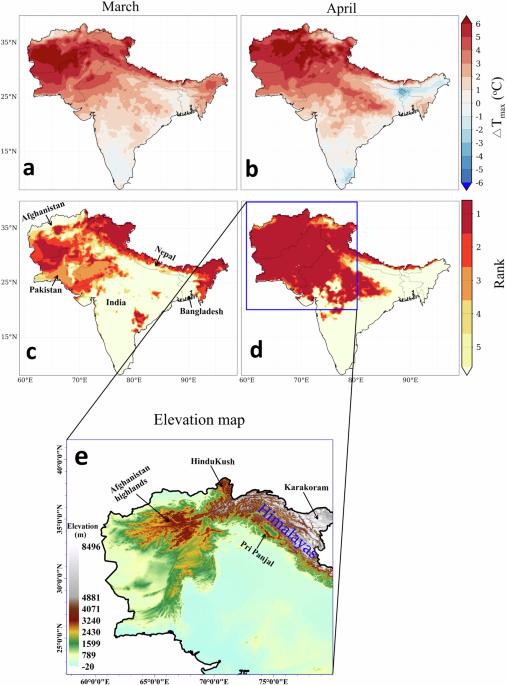Unveiling the devastating effect of the spring 2022 mega-heatwave on the South Asian snowpack
IF 8.1
1区 地球科学
Q1 ENVIRONMENTAL SCIENCES
引用次数: 0
Abstract
Global warming has led to a notable increase in heatwaves globally and regionally. In spring 2022, South Asia witnessed an unprecedented heatwave with temperatures breaking historical records and exceeding 5° C from climatological mean at several locations in the northern Indian subcontinent. Here, using 3D tracking, this heatwave ranked the most severe in the past 64 years, characterized by its protracted duration and wide spatial extent. The excess atmospheric heat, represented by temperature anomalies, during the mega-heatwave triggered rapid snowmelt across the snow-covered areas in the region, leading to an average loss of 42% in snow cover and 57% in snow depth of the regional snowpack. This rapid melting resulted in the complete disappearance of low-level snowpack in the western Himalayas, Pir Panjal, and Afghanistan highlands, leading to the lowest snowpack observed in the last six decades. Moreover, during the heatwave, the amount of snowfall received was only 29% of the long-term average. This combination of excessive melting and reduced snowfall culminated in a severe regional snow drought in spring 2022. The heatwave genesis lay a persistent high-pressure system over Northwest South Asia, reinforced by a quasi-stationary Rossby wave packet over Europe during the initial spell. Continuous heat from high-pressure ridges associated with circumglobal Rossby waves combined with the physical barrier of the Himalayas, lent staying power to this system during the second phase. An unprecedented heatwave in South Asia driven by a persistent high-pressure system coupled with a Rossby wave packet during spring 2022 led to an average loss of 42% in snow cover and 57% in snow depth of the regional snowpack, according to analysis of satellite observations and ERA5 reanalysis data.

揭示 2022 年春季特大热浪对南亚积雪的破坏性影响
全球变暖导致全球和地区热浪明显增加。2022 年春季,南亚出现了前所未有的热浪,印度次大陆北部多个地点的气温打破了历史记录,与气候学平均值相比超过了 5 摄氏度。在这里,利用三维跟踪技术,这次热浪是过去 64 年中最严重的一次,其特点是持续时间长、空间范围广。特大热浪期间以温度异常为代表的过量大气热量引发了该地区积雪覆盖区域的快速融雪,导致该地区积雪覆盖面积平均减少 42%,积雪深度平均减少 57%。这种快速融化导致喜马拉雅山西部、皮尔潘贾尔山和阿富汗高地的低层积雪完全消失,从而使积雪量达到过去六十年来的最低水平。此外,在热浪期间,降雪量仅为长期平均值的 29%。过度融化和降雪量减少的共同作用导致 2022 年春季出现了严重的区域性雪旱。热浪的起源是南亚西北部上空的持续高压系统,在最初的热浪期间,欧洲上空的准静止罗斯比波群加强了这一高压系统。与环全球罗斯比波相关的高压脊产生的持续热量加上喜马拉雅山的物理屏障,在第二阶段为这一系统提供了持久动力。根据对卫星观测数据和ERA5再分析数据的分析,2022年春季南亚地区由持续高压系统和罗斯比波群驱动的前所未有的热浪导致该地区积雪覆盖面积平均减少42%,积雪深度平均减少57%。
本文章由计算机程序翻译,如有差异,请以英文原文为准。
求助全文
约1分钟内获得全文
求助全文
来源期刊

Communications Earth & Environment
Earth and Planetary Sciences-General Earth and Planetary Sciences
CiteScore
8.60
自引率
2.50%
发文量
269
审稿时长
26 weeks
期刊介绍:
Communications Earth & Environment is an open access journal from Nature Portfolio publishing high-quality research, reviews and commentary in all areas of the Earth, environmental and planetary sciences. Research papers published by the journal represent significant advances that bring new insight to a specialized area in Earth science, planetary science or environmental science.
Communications Earth & Environment has a 2-year impact factor of 7.9 (2022 Journal Citation Reports®). Articles published in the journal in 2022 were downloaded 1,412,858 times. Median time from submission to the first editorial decision is 8 days.
 求助内容:
求助内容: 应助结果提醒方式:
应助结果提醒方式:


